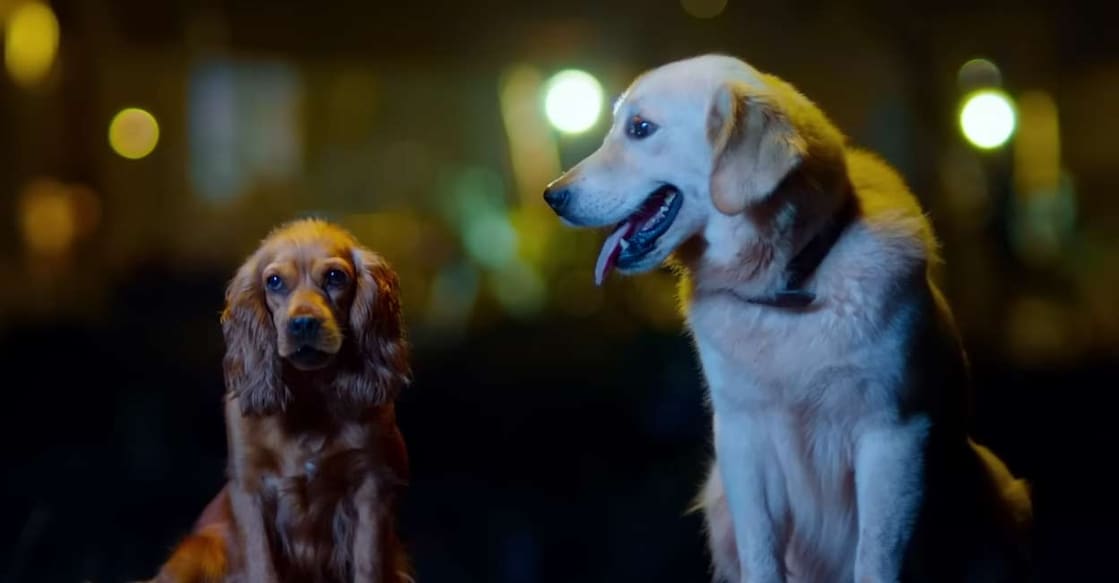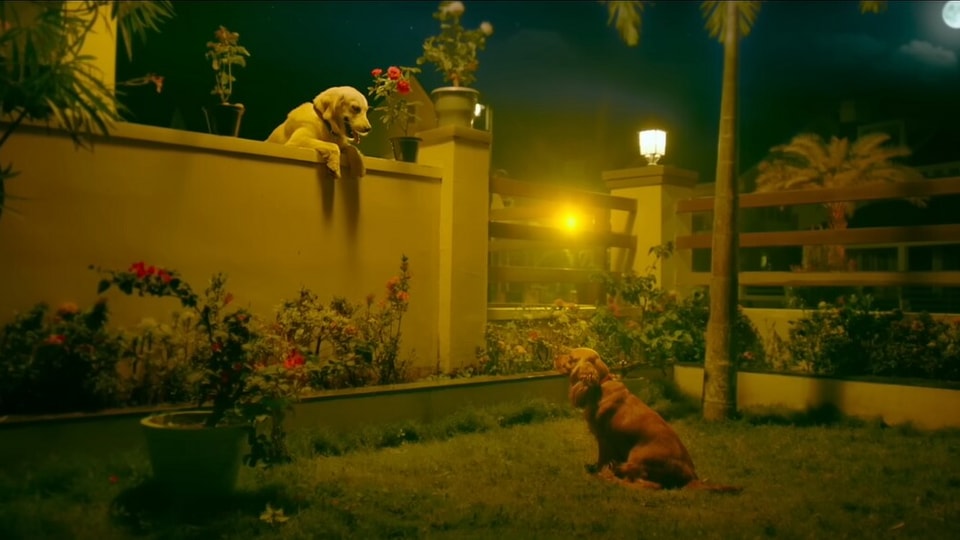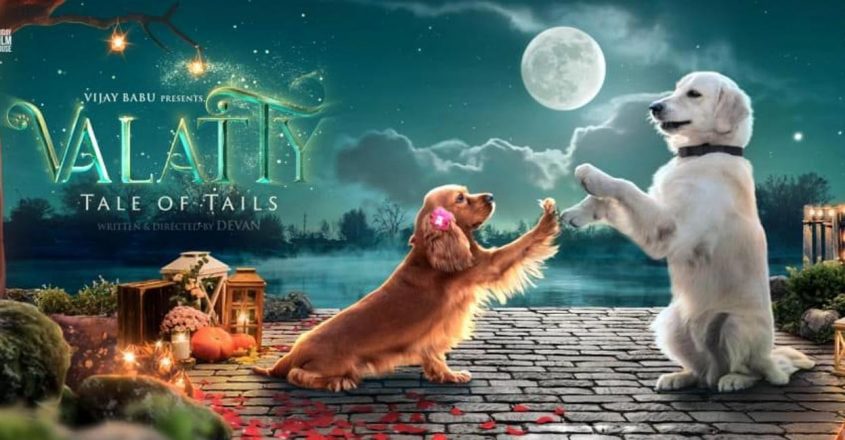A straightforward canine story, ‘Valatty’ charmingly resonates with kids and dog enthusiasts, but the absence of prominent canine characters is a missed opportunity in the plot.
Synopsis

Enter the enchanting tale of Amalu, a spirited cocker spaniel, and Tomy, a charming golden retriever, whose love blossoms despite their families’ disapproval due to differing backgrounds. Amidst the backdrop of different “religions” within their respective households, the canine couple faces rejection. Faced with the threat posed by their families, Amalu and Tomy embark on a daring escapade, deciding to elope and venture into the unknown. However, as house pets, their naivety about the world beyond their homes sets the stage for an extraordinary journey filled with unforeseen challenges and adventures. Join these courageous pups as they navigate the complexities of love and life beyond their familiar surroundings.
Review

Once you overlook the whimsy, Valatty emerges as a delightful family film, particularly appealing to children. Its charm and humor shine through, creating an endearing and amusing experience. The film’s highlights revolve around the lively interactions among the animals, featuring talking dogs and playful encounters with cats. The essence of a cute dog movie is captured in these moments.
However, the movie stumbles when it emphasizes the human angle, making it less relatable and introducing an awkward, fantastical element. The film’s potential could have been maximized if it had fully embraced its identity as an animal-centric story. The heartwarming bond between humans and their canine companions is inherently compelling, and transforming dogs into humans detracts from the natural charm of their connection. The magic lies in animals aligning with humans while maintaining their unique, animalistic qualities.

The notion of dogs communicating in Indian languages is undeniably amusing; however, there are moments in the story where it seems more about two humans than actual dogs. While the concept of two dogs falling in love is acceptable, the film fails to capture the authentic essence of canine behaviour. Even when dogs converse in human languages, they need to retain their inherent dog-like characteristics. The narrative should honour the genuine nature of dogs, emphasizing that even those with the ability to speak human languages are, fundamentally, dogs and cannot transform into humans donning animal exteriors.
As the storyline unfolds towards its culmination, a barrage of exposition dumps emerges, becoming a stumbling block for the movie, and its recovery becomes questionable. As highlighted earlier, the film finds its niche among younger audiences seeking an adorable and straightforward viewing experience, devoid of intricate narrative demands. However, for those anticipating a well-crafted and emotionally resonant screenplay, Valatty might not meet those expectations. The depiction of corrupt dog snatchers falls into the familiar trope of Disney villains, lacking the depth or complexity that could elevate them beyond one-dimensional, inherently evil characters. The climax, marred by excessive information dumping, marks a critical juncture where the movie grapples with sustaining engagement. Despite its moments of charm and humour, Valatty faces challenges in delivering a compelling and nuanced narrative, particularly for viewers seeking a more sophisticated storytelling experience.

The primary flaw in Valatty lies in the underdeveloped nature of its characters, as none of them emerge as fully realized individuals. Instead, they serve specific roles merely to propel the narrative forward. This lack of multidimensionality is particularly jarring, as the characters appear singularly focused with little depth or complexity. Without delving into spoilers, the portrayal of individuals in the movie seems unrealistic, given that real people are capable of managing various responsibilities concurrently. The characters in Valatty come across as either disdainful toward animals or lacking understanding of them, presenting a peculiar and somewhat disconcerting dynamic. The pervasive negative portrayal of characters as seemingly unsympathetic or oblivious to animal welfare adds an odd layer to the narrative, creating an overall perplexing viewing experience.
Regardless, the second part takes an unexpectedly gloomy turn, introducing a level of depression and intensity that seems entirely unwarranted. The question of why a movie like this couldn’t maintain a simpler, lighthearted tone with a touch of drama remains perplexing. The abrupt shift towards darkness might leave viewers somewhat traumatized during the latter half, deviating from the anticipated light-heartedness. Additionally, this tonal shift elongates the runtime needlessly, potentially causing some frustration. What began as a “romance” film centred around dogs surprisingly transforms into a public safety PSA, diverting from its initial premise. This unexpected thematic twist, coupled with the sombre tone, may leave audiences feeling perplexed and questioning the necessity of such a narrative shift in what was initially anticipated to be a more straightforward and charming movie.

Valatty’s attempt to transcend its initial premise becomes its downfall, morphing into a grandiose human-centric movie masked under the guise of animals. The narrative’s expansion into a larger-than-life portrayal of human experiences through animal characters feels contrived, creating a sense of artifice. The film endeavours to evoke fear for the safety of dogs, but the execution seems forced, lacking authenticity. While the concept of animal testing is a real concern, Valatty stretches the boundaries of realism and relatability. The attempt to humanize animals to an extreme degree diminishes the genuineness of the storytelling, making it challenging for viewers to connect with the narrative on a plausible and emotionally resonant level. This deviation from the original essence proves detrimental as the film grapples with maintaining coherence and a believable connection to real-world issues.
Verdict

Valatty takes a peculiar approach by treating dogs as if they were human characters, ultimately becoming their own undoing. Embracing the canine nature and recognizing them as dogs, not humans, would have elevated the story into a more relatable and heartwarming narrative. The excessive emphasis on elements introduced in the second half of the film feels odd and detracts from the overall enjoyment. The deviation from a straightforward and lighthearted experience into whatever unfolds in the latter part adds an unusual and somewhat disconcerting layer to the storytelling. Despite the peculiarities, the movie manages to inject a bit of excitement through vigilante justice in the conclusion, offering a redeeming element of fun.




